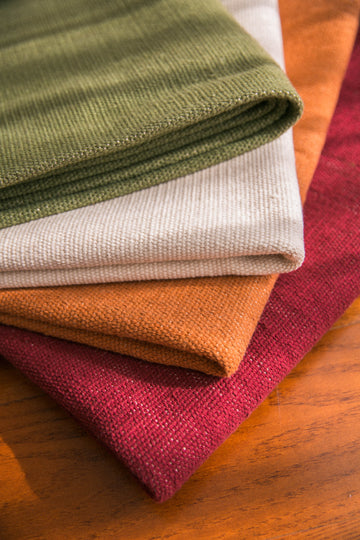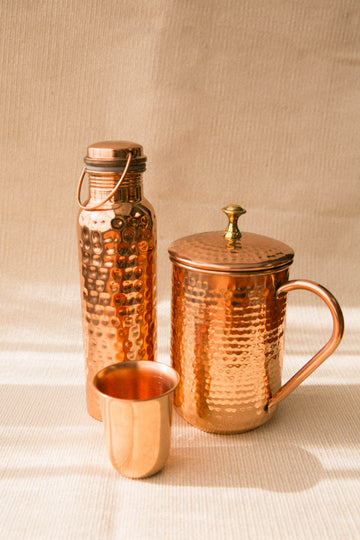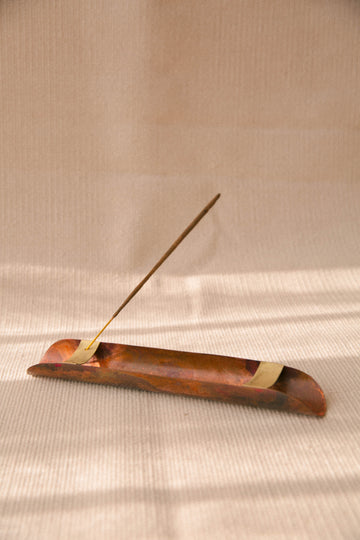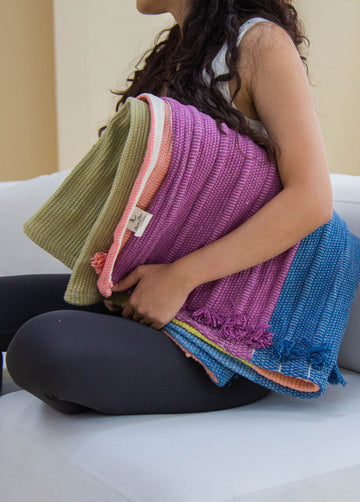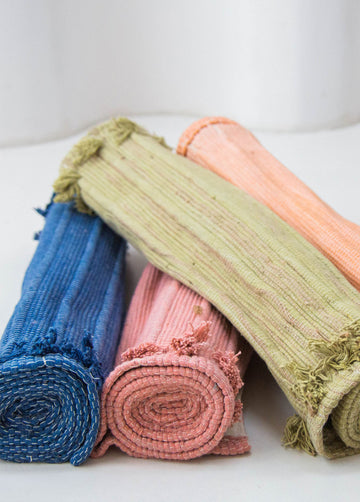Herbal Dyeing Process
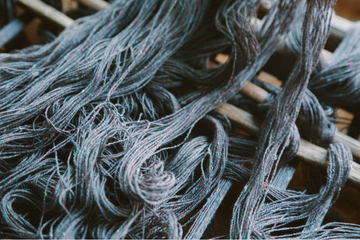
Herbal Dyeing Process
A Vedic invention, still preserved in it’s purest form. The skin being the largest and most absorbent organ of our body, absorbs what we feed it, and what we feed it can either enhance or negate our well-being. This knowledge guided Indian sages to create Natural herbal dyed textiles, a method of dyeing cloth with medicinal herbs to enhance well-being through constant exposure and touch.
The entire process is carried out in it’s authentic form without the use of any machinery or chemical additives. Over 60 Ayurvedic herbs are used in different proportions and different applications to dye one colour. The colour represents the pre-dominant herb, the herb that gives the yarn it’s medicinal property. A herbal concoction or “Kashayam” is prepared by carefully measuring and blending these 60 different herbs, barks, roots and flowers. Different stages of the dyeing process make use of different “Kashayams” which have a specific role to play, and each colour has it’s own unique formulation.
The process is manual and carried out on 100% pure organic cotton yarn. Conventionally grown cotton uses the maximum amount of chemical pesticides and insecticides. When our skin comes in contact with such cotton, it naturally absorbs the residue of these chemicals. To avoid contact with chemicals and prevent eco-toxicity we choose organic yarn in our mats. All waste produced during the dyeing process, being fully natural and plant based, is used as bio-manure.
The yarn goes through multiple stages before it becomes charged with the prana of the health-enhancing herb. The process to create an Herbal dyed cotton mat lasts upto a month including the time spent on the weaver’s loom.
Herbal Dyeing Stages
Pre Processing or Bleaching
The bleaching is done to remove the naturally existing dull colour and also removes the impurities present in cotton or yarn. This process is done through several stages of treatment against germs and other dust particles, which could compromise the quality of the fabrics in the later stages. The 100% natural bleaching process is done using sunlight, soap nuts & antibacterial herbs etc.

Dyeing
Herbal concoctions or “Kashayams”, prepared by combining a number of herbs, in specific proportions, are used as dye baths for the pre-mordanted yarn. The yarn is soaked in the dye bath multiple times at a specific temperature for a set period of time. All these variables are dependent upon the colour/medicinal property that is desired. The yarn is then allowed to cool, and washed repeatedly to rid it of any residues. The dye extracts are directly taken from medicinally rich herbs. The herbs itself will act as mordents and dye, the shades are earthly and there is no touch of any synthetic chemicals. The procedure is carefully carried out according to the traditional instructions to preserve this unique method of natural dyeing.

Finishing
In Herbal dyeing, the finishing process begins by sprinkling pure water in small quantities and with periodic intervals on the cloth. This pure water sprinkled fabric is once again treated with a 100% organic dispersants solution to remove the unfixed in yarn or fabrics to give an even feel to the fabric.

Softening & Drying
The freshly dyed fabrics are usually too hard usually. The softening process is done cold with 100% organic oils such Coconut oil or Castor oil depending on the fabric or yarn. The dyed yarn are dried in shades and kept for prolonged periods for the longevity of the fabrics.
Recycling Plant
Solid and liquid waste is separated through the process of filtration and used for farming purposes as manure and for watering the fields. The discharged water or the solid waste do not contain any harmful chemicals.
Benefits of Herbal Clothings
The health benefits of herbal clothing and its usage depends on the theory of touch. The body loses toxins when it comes in contact with herbal clothing and this improves metabolism. Herbal clothing is also known to help fight against many common diseases like diabetes, hypertension, skin allergies, asthma and heart ailments.
The human body naturally heals itself when sleeping or meditating. Thus, when the body is at rest, herbal clothing will work most effectively. The skin is known as the largest organ of the body. It acts as a fence and protects the body but it can also be the channel for outside germs and toxins to enter the body. Herbal clothing helps to stand like a guard against harmful toxins about to enter the body through the skin. That is why they are beneficial for health.
That is why herbal textile is mainly used in making sleepwear, undergarments, bed coverings, towels, meditation clothing etc that remains close to the skin absorbing all the benefits it gives out. Herbal textiles are also used in home textile products like mattresses, coir mats, door mats, bath towels, bed spreads and carpets. When making coir mats using herbal fabric, the fibers are first soaked in herbal dyes and then woven into coir mats.
Some of the common herbs used:
Neem (Azadirachta Indica)
In some parts of India the neem leaf and flower are considered so special that they play a role in weddings, festivals, celebrations and worship. It is often consumed in the summer months to balance the Ayurvedic dosha of pitta, and consumed with jaggery to remind of the bitter and sweet tides of life. Nimbin, the organic chemical compound derived from the neem plant, is thought to be the producer of the anti-inflammatory, antiseptic, and antihistamine properties that make this plant so medicinally rich. Being widely available in India, this multipurpose plant is known affectionately as ‘the village pharmacy.

Holy Basil / Tulsi (Ocimum Sanctum)
Wild Tulsi / Holy Basil Tulsi is also known by many other names that reflect the exalted position it holds in Ayurvedic medicine. Holy Basil, Queen of Herbs, the Elixir of Life and the Mother Medicine of Nature are some of the monikers given to it. Tulsi is rich in antioxidants and other nutrients. Tulsi is a known antiseptic, anti-fungal, anti-bacterial and anti-viral which make it effective in fighting infections. Tulsi is the primary ingredient in providing the green color to our Earthy/Bhumi yoga mat that helps you to stay secure, stable and grounded.
Sappan Wood / Red Sandalwood
Red Sandalwood is known for a variety of medical uses such as fluid retention, treating digestive tract problems, purification of blood and treatment of coughs. Red Sandalwood Powder which is also known as Raktha Chandana Powder has been used in Ayurvedic medicine as an antiseptic, skin conditioner, wound-healing agent and as an anti-acne treatment Red Sandalwood is the primary ingredient in providing the mellow red tinge to our Fire/Agni yoga mat that makes you feel alive, have the self-esteem and vigor to take action.
Neelini / True Indigo herb
Indigofera tinctoria (Neelini Herb or True Indigo) is a plant species from the Fabaceae family that was and still is one of the natural sources for indigo dye. Aside from being a dye source, Neelini is known for its use to treat spleen and liver disorders, fever, gray hair, rheumatoid arthritis, and other ailments. In Ayurveda, this herb is used mainly as an antidote or as an anti-venom. Neelini is the primary ingredient in providing the blue hue to our Water/Jal yoga mat that makes you feel balanced, creative and receptive to change. Like the great oceans and its tides, it allows you to be in the flow.

Vembadam
Vembadam is known for its effective cure for body ache, bunion, and colic. The bark is used for skin diseases as it has anti-allergic properties. The root bark is used to treat flatulence and it promotes wellness of the gastrointestinal tract. Vembadam is also known for its use in the healing of cuts and wounds. Vembadam is the primary ingredient in providing the grey shade to our Air/Vayu yoga mat that allows you to be empathetic, compassionate and have a feeling of content.

Aloe Vera (Aloe Barbadensis Miller)
The watery gel that seeps out of a snapped Aloe Vera leaf is 96% water, leaving just 4% to hold the magical concoction of vitamins, amino acids and enzymes that led the Egyptians to deem it the ‘plant of immortality’. According to Ayurvedic medicine, this lily family plant can be used to treat numerous health concerns from spleen disorders and asthma to skin burns and abdominal tumours. We use aloe vera as part of our alternative to chemical bleaching, together with other natural ingredients like white rose, soap nut and sunlight. This natural whitening process takes place before colouring, ensuring the fabric used for our underwear and basics begins as a bright and pure surface without the tonal variations found in raw organic cotton.
Karungali (Acacia Catechu Wild)
A moderate sized tree with dark yellow inflorescence commonly growing throughout Sub-Himalayan belt and north-eastern states of the country. Ayurveda uses wood and bark of the tree for various formulations Cutch tree finds its major application in the treatment of skin and respiratory problems more in particular, of allergic origin. Also, it is used as an important constituent for maintenance of oral hygiene and also as local treatment for bleeding injuries as styptic agent by virtue of its astringent properties.
Vetiver (Vetiveria Zizanioides)
Vetiver, also known as Khus in Ayurveda, is a tall perennial aromatic grass that makes its refreshing presence felt as one of the many pleasures of Summer in India. Indigenous to the south of India, the plant has been revered divine for centuries due to its ability to thrive during the searing heat and its calming and cooling properties. Vetiver has also been used for cosmetic preparations owing to its natural affinity to the skin and the healing properties of its fragrance that benefit both the body and the mind. Ayurveda reads that the aroma of the Vetiver essential oil strengthens and connects all functional aspects of the mind through its healing and balancing properties – the vibrational frequencies of Vetiver are so uplifting and effective, they are known to reach the mind and bring peace instantly.

Madder (Rubia tinctorum)
Indian madder is an herb which is a widely used herb in Ayurveda and Siddha system of medicine. The earliest references of the herb dates back to the Vedic period, in the Aiteraya Aranyaka. The herb was and still is an important part of ancient Indian religious rituals. Talking about its medicinal value, the herb was used to treat skin diseases, arthritis, ulcers, wounds and has cosmetic value. It is a blood purifier and improves the texture and complexion of skin. The herb is traditionally used to purify blood and pacify sudden pain. Ayurvedic texts also describes several cosmetic preparations using the same. It is effective in reducing acne and pimples1, increases complexion and purifies blood.
